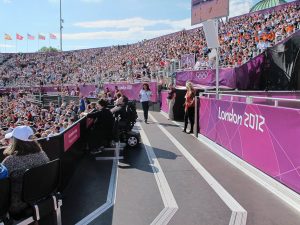Last but not least
Why thinking about overlay design at the start of an event programme is a good idea for everyone involved. Event overlay experts Ana Loreto Vasquez and Maria Canovas explain why good overlay planning is so important.
Mention the words ‘overlay design’ to anyone involved in delivering an Olympic Games and, chances are, they will think of those busy final stages of the preparations when the temporary structures such as tents, cabins and scaffolding are installed, and the venues and infrastructure are made ready for the start of the competition.
To a certain extent, that is a fair picture. Yet these temporary structures and final construction details are just part — a critical part, admittedly — of the overlay architect’s job description. “Overlay design is much more than tents, toilets and temporary venues,” says Ana Loreto Vasquez. “It creates detailed plans for running the whole event and also ensures everyone who comes to see the Games has a once-in-a-lifetime experience.”
Good operational design
It is all about good operational design, says Vasquez. “We try to see things from the perspectives of everyone involved — the spectators, athletes, camera operators, the press, all of the client groups — and get the best result for all of them,” she explains.
This involves getting to grips with every part of the event. As well as understanding the governing body’s standards and guidelines, you need a detailed knowledge of the host city, the venues and the space, to figure out how it can accommodate those guidelines in the best way.
Why to start?
“Ideally, this should all be considered at the very beginning,” says Vasquez. “Starting your overlay design early means you can get to grips with all this, and optimize the people and resources you need.”
Overlay design teams can help even at the bid stage. Vasquez says that overlay specialists can support cities as they choose their venues and sites, help them shape the Games masterplan to make of the most of their infrastructure and provide the best backdrop for each sport.
However, it is really once the host city has been announced that overlay teams come into their own. “Our plans feed into almost every part of the Games,” says Vasquez. Overlay teams interact constantly with all the operational teams in a dynamic process, planning each venue and helping define an event’s operational plan.
Hands-on expertise
They work closely with transport and security, helping define the best strategy to support the mobility and safety of the Games. They help ensure procurement is cost effective. And, of course, they build the temporary elements and operate the event.
“A host city will make sure its Olympics are always a success,” adds Vasquez. “But hands-on overlay expertise can make getting there a whole lot smoother.”
Vasquez and her team have put together overlay programmes for several Olympic Games, as well as for other major sporting events. The team is currently involved in the some of the biggest sports events coming up in next few years.
A different scale
“An Olympics or Commonwealth Games has a different scale from other championships,” says Maria Canovas. “At any one time, there could be many different events happening at many multiple sports venues across a city. Things are also going on in the non-competition venues such as the Athlete’s Village, the International Broadcast Center, and the training venues, not to mention the logistics warehouses and transport hubs.”
Among all this activity, maintaining a joined-up spectator experience is critical. “You could have the best stadium, with the best technology, but if your train breaks down on the way there, it can ruin your day.”
This is why good overlay planning is so important. “Our overlay teams know the venues from the corridor level up,” Canovas explains. “They are the people who see the importance of how everything fits together, from the detail of a single room to the way an Olympic Park interacts with the rest of the city. We look at the whole picture.”

In short, overlay design helps ensure that the venues and site can successfully host the operation of an event.
Overlay design: A timeline
9 years before opening ceremony
The bid: From applicant to candidate
- Venue evaluation: Analyzing venues and sites for the feasibility study
- Masterplan support: Working with infrastructure, transport and security teams to choose the best venues and sites for sports and operations
- Bid Book preparation: Helping create detail answers to the international Olympic Committee questionnaire
- Legacy planning: Writing legacy briefs for venues and economic impact studies
4 years before opening ceremony
Phase 1: Scope and masterplan
- Building the team
- Venue briefs/requirements
- Scope definition/agreement
- Masterplan optimization
- Overlay block planning
- Budget preparation
- Integration with public works authorities on new venue designs
- Interface with stakeholders
- Strategic planning and programme development
3 years before opening ceremony
Phase 2: Planning and design
- Overlay design management: Covers all stages of the design process, taking it from block plan, through concept design, to schematic and detailed design
- Venue/scope lockdown
- Functional area specific drawings
- Venue operational planning
- Procurement
- Statutory consents including town planning and building control
- Engineering services design
1 year before opening ceremony
Phase 3: Delivery and installation
- Coordination of design, including overlay contractors drawings
- Design freeze
- Construction drawings
- Test events
- Overlay installation: Liaising with contractors and construction management support to ensure consistency and on-time delivery
- Site and venue management
After the games: Transition to legacy
- Assisting in the transition from event to legacy use. Ensuring that plans focus only those elements that are viable in legacy mode.






